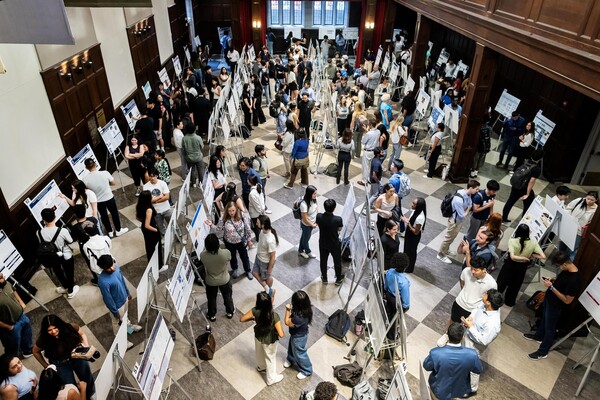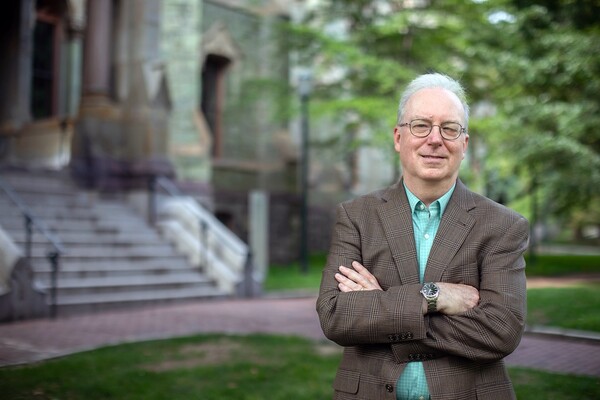
Image: Mininyx Doodle via Getty Images
Meaningful global engagement is central to President Amy Gutmann’s vision for the future of the University of Pennsylvania. As such, it figures prominently in Penn Compact 2020, the strategic plan that steers the direction of the University and pioneers new paths for higher education to make a positive global impact. Achieving this goal has never been so critical: Universities in the United States and all over the world are seeking ways to facilitate the international understanding that is critically needed to mend a fractured global landscape.
“Our commitment to global engagement is essential to what I call ‘educational diplomacy,’” says Gutmann. “Now more than ever, we are bringing Penn to the world and the world to Penn. And in doing so, we are building stronger cross-cultural connections, deeper relationships, and mutual understanding within the global community.”
But becoming a global agenda-setter doesn’t happen overnight, and it doesn’t happen by accident.
Under Gutmann’s leadership, Penn’s global engagement has come to encompass more than 6,000 international students and scholars on campus, 1,181 faculty reporting internationally focused research and teaching, more than 233 international institutional agreements and partnerships, and more than 2,500 Penn students each year studying abroad. And beyond the 177 countries to which Penn faculty and students travel, the Penn Online Learning Initiative brings Penn-generated knowledge to 2.4 million learners around the world annually.
This multivalent activity is taking place in all four undergraduate and all 12 graduate and professional schools, through curricular and co-curricular programs, and making a meaningful impact in myriad ways.
“Global engagement isn’t an appendage to our main mission,” says Amy Gadsden, executive director for global initiatives. “It is woven into every aspect of our mission.”
One of Gutmann’s first steps in expanding Penn’s global engagement was to create the office of the Vice Provost for Global Initiatives in 2011, and she appointed Ezekiel Emanuel, former policy advisor for the Clinton and Obama administrations, to the titular role.
“I often said that using education and management skills to address the human resource deficit in developing countries would have a tremendous amount of impact,” says Emanuel. “Coming here, to a major university committed to global engagement, gave me a chance to actually execute that idea.”
Together with Penn Provost Vincent Price, Emanuel was tasked with developing a University-wide global strategic framework. They started by identifying three core values on which to base it—understanding, engagement, and impact—and emphasizing the importance of taking an interdisciplinary approach to their implementation.
Interdisciplinary research and teaching strengthens Penn’s global strategy by continuing to draw the world’s most innovative thinkers to the University, such as Beth Simmons, the Andrea Mitchell University Professor in Law and Political Science and an expert in international law and human rights. Simmons has authored two seminal books in the field, along with numerous other publications, and served as President of the International Studies Association.
Simmons, who holds appointments in Penn Law and the School of Arts & Sciences, came to Penn in July 2016 under the auspices of Gutmann’s Penn Integrates Knowledge (PIK) initiative to recruit and retain faculty whose groundbreaking work can’t be contained in traditional academic disciplines. At Penn, Simmons can conduct her research and scholarship unfettered by departmental boundaries and has potential collaborators at 12 schools, all less than a mile from her office.
“Beth exemplifies Penn’s commitment to expand faculty hiring in the global international space, particularly touching on big policy challenges,” says William Burke-White, Richard Perry Professor, professor of law, and director of the newly opened Perry World House. An expert on international law and global governance, Burke-White was the principal drafter of Hillary Clinton’s hallmark foreign policy and institutional reform initiative when she was Secretary of State.
“Beth is someone who can catalyze a huge amount of activity and excitement in this space,” he says.
Nicholas Sambanis, Presidential Distinguished Professor of comparative and international relations in the School of Arts & Sciences’ Political Science Department, is another notable new faculty member whose work has important policy implications. Sambanis was among the first in his field to study civil war and ethnic conflict—a complex issue that has arguably become the most urgent international issue facing policymakers and citizens today.
The creation of unbiased, world-relevant knowledge necessitates a learning environment informed by the world’s rich diversity. The Penn Compact 2020 refers to this imperative as “Bringing the World to Penn,” and it has inspired the growth of the University’s international campus community where members hail from more than 130 countries and territories and represent a variety of races, religions, passions, experiences, challenges, hopes, and goals. Approximately one student in seven in the Class of 2020 is an international student—or 14 percent. In 1980, that number was less than 1 percent.
Penn’s international community contributes to and benefits from the diverse urban setting of Philadelphia. Located within commuting and event-hopping distance from both Washington and New York City, the University has fostered a proliferation of 176 research centers with a global focus. These are supported by campus leaders ranging from the Vice Provost for Global Initiatives and the Vice Provost for University Life to the deans of Penn’s 12 individual schools. And the September 2016 opening of the Perry World House now provides a campus hub to connect and unify all these initiatives.
“Schools more commonly start by building a campus hub for global engagement, and then get everybody to participate and partake,” says Gadsden, “but the opening of Perry World House actually reflects a tremendous amount of ongoing activity that now benefits from a central support to take us to a new level of global engagement.”
Penn welcomed visits from leaders such as former Secretary of Defense Robert Gates, former UN High Commissioner for Human Rights Navanethem Pillay, and the President of Mongolia within the first week of Perry World House’s opening. While the appearance of global leaders at Penn is far from novel, the stunning new building in the middle of campus has already integrated such activity into the broader life of the University, engaging students and faculty from disciplines well beyond those that normally focus on international relations.
Gutmann has also recognized that creating and sustaining a truly global university is a bidirectional undertaking that compels its students and faculty to go out into the world as much as it welcomes the world to them.
“America has always been a magnet for talented, ambitious people from all over the world,” says Geoff Garrett, dean of the Wharton School, “but this had the unintended consequence of enabling the U.S. to become a somewhat parochial country.”
Garrett’s perspective is informed by his own international status. “I grew up in Australia, a small and isolated country where you don’t think the world is going to come to you. You’ve got to go to the world. And that’s what the U.S. will have to be more proactive about in the 21st century. The world will continue to come to America. We should balance that by going more to the world.”
Garrett gives two reasons for this intellectual and cultural imperative.
“One, you can read about the world all you like, but until you’ve actually been there and felt it, it’s not so real. And two, going out in the world carries symbolic power, such as with the Penn Wharton China Center (PWCC).”
Launched in the spring of 2015 in Beijing’s World Financial Center, the PWCC augments the ability of Wharton and Penn’s other 11 schools to expand the research, scholarship, and partnerships they had already fostered in China. And, Garrett says, “the amount of pride, excitement, and energy it has generated among Chinese friends of Penn cannot be overstated.”
Penn and Wharton opened the PWCC at a time when peer universities had been opening actual campuses overseas.
“We looked at that approach and decided not to follow the trend,” says Gadsden. Instead, Penn followed the ethos that has always guided its global engagement: an ethos that seeks to learn as well as teach; listen as well as speak. An ethos that embraces collaboration and the exchange of knowledge, and rejects the “ivory tower” attitude which has segregated the act of scholarship from its purpose of serving the world.
This vision has also guided the increasingly global reach of Penn’s Perelman School of Medicine (PSOM) and informed the strategic reorganization of PSOM’s Center for Global Health (CGH) in 2015.
“We’d been involved in the global health space for a long time, and made a significant impact on communities around the world,” says Glen Gaulton, vice dean and director of CGH, and PSOM professor of pathology and laboratory medicine, “but our initiatives were not previously linked in an institutional strategic vision or plan—they are now.”
By adopting the University’s framework for global initiatives, he says, the CGH has been able to bring all its projects together, maximizing its impact on the most vulnerable communities around the world.
“For every critical world issue, there are Penn faculty who are researching it, teaching it, and working to find a solution to it,” says Gutmann. “But that alone is not what makes Penn a leader in the international space. Rather, it is our threefold strength of setting priorities, coalescing people, and leveraging optimal synergies across Penn’s 12 outstanding schools that makes our global engagement more than the sum of its parts.”
This hallmark strength continues to attract some of the world’s most transformative scholars, researchers, and policymakers to Penn—and it has provided countless Penn students with the intellectual and practical tools to transform their passions into world-changing innovations and start-ups, as the President’s Engagement Prize winners and President’s Innovation Prize winners attest.
“Every venture capitalist will tell you the difference between a successful and unsuccessful company is not who has the better idea. They all have great ideas. It’s whether or not they can actually execute,” says Emanuel.
Which is precisely what Penn empowers its faculty, students, and global collaborators to do.
“That’s what it’s all about,” he says.

Image: Mininyx Doodle via Getty Images

nocred

Image: Pencho Chukov via Getty Images

Charles Kane, Christopher H. Browne Distinguished Professor of Physics at Penn’s School of Arts & Sciences.
(Image: Brooke Sietinsons)